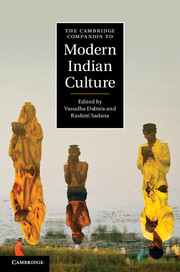Book contents
- Frontmatter
- Introduction
- Part I Cultural contexts
- Part II Cultural forms
- 6 The Bengali novel
- 7 Writing in English
- 8 Dalit life stories
- 9 National tradition and modernist art
- 10 Mass reproduction and the art of the bazaar
- 11 Urban theatre and the turn towards ‘folk’
- 12 Aesthetics and politics in popular cinema
- 13 Musical genres and national identity
- 14 Voyeurism and the family on television
- Further reading
- Index
- Cambridge Companions to Culture
6 - The Bengali novel
from Part II - Cultural forms
Published online by Cambridge University Press: 28 May 2012
- Frontmatter
- Introduction
- Part I Cultural contexts
- Part II Cultural forms
- 6 The Bengali novel
- 7 Writing in English
- 8 Dalit life stories
- 9 National tradition and modernist art
- 10 Mass reproduction and the art of the bazaar
- 11 Urban theatre and the turn towards ‘folk’
- 12 Aesthetics and politics in popular cinema
- 13 Musical genres and national identity
- 14 Voyeurism and the family on television
- Further reading
- Index
- Cambridge Companions to Culture
Summary
The Bengali novel originated in the nineteenth century as a product of the colonial encounter, though it drew upon a multiplicity of literary traditions, indigenous as well as foreign. Like its counterpart in Europe, it is linked to the social, domestic and intellectual aspirations of a new bourgeoisie, the spread of print culture, the growth of urban centres and the formation of a middle-class readership hungry for novelty and diversion. But the conditions for its inception and development in colonial Bengal are clearly distinct from those of eighteenth-century Europe, making the novel both witness to and participant in the creation of a distinctly Indian modernity. In its representational function, it records not just the self-imposed compulsions of this process, but its fissures and uncertainties, opening up a space for moral, emotional and intellectual debate. At the same time, it becomes the site for an entirely new set of experiments with literary language and the techniques of representation.
Print, the public sphere and public culture
The coming of print and the consequent opening up of the public sphere is clearly the inaugural moment of this history. The first Bengali typefaces precede the novel by little more than half a century, with the publication of Nathaniel Brassey Halhed's A Grammar of the Bengal Language at Hooghly in 1778, using moveable metal type designed by Charles Wilkins. From 1800 onwards, missionary activity at Serampore and the establishment of the College of Fort William make printing in Bengali a necessary part of the colonial project, and contribute to the development of discursive prose through early narratives such as the Raja Pratapaditya Charitra (1801) composed by Ramram Basu for his students at Fort William.
- Type
- Chapter
- Information
- The Cambridge Companion to Modern Indian Culture , pp. 99 - 123Publisher: Cambridge University PressPrint publication year: 2012
- 11
- Cited by



